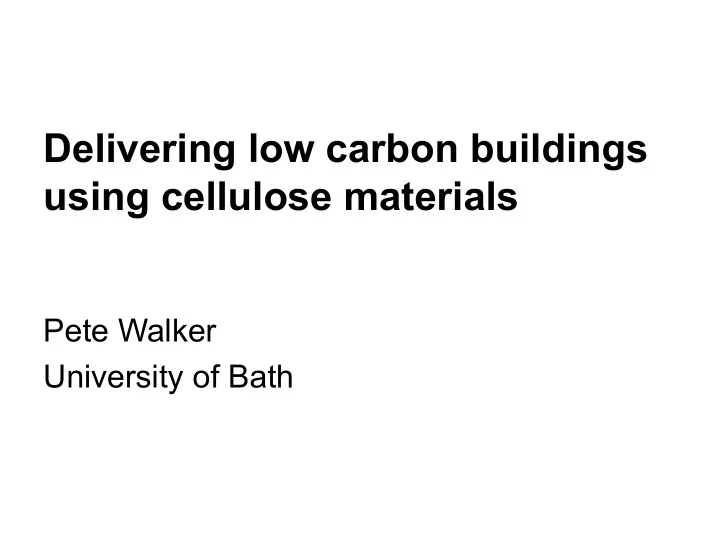

Delivering low carbon buildings using cellulose materials Pete Walker University of Bath
Opportunities for natural materials in modern construction • Reduced GHG emissions Lower embodied carbon (stored carbon) Improved building performance • Resource efficiency Renewable supply Reduced waste • Healthier buildings • New agricultural markets
Traditional natural materials • Craft based • Weather dependent: seasonal construction • Labour intensive • Slow • Expensive • Concerns for inferior durability • Concerns for poor structural resilience • Unregulated supply chain • Lack of certification, regulations, standards
Market development: barriers for natural materials • Certification (lack of) • Cost • Financing • Perceptions of poor performance • Supply chain • Warranty (lack of)
Products not Materials
Prefabricated Straw Bale Insulated Panels: ModCell • Main components: • Timber framed panels • Straw bale infill • Lime:sand render • Manufactured off-site in temporary flying factories • Panels’ designed to be dismantled, reused and recycled
Manufacture
Construction
Environmental Performance Testing Air ¡permeability: ¡0.86 ¡m 3 /hr ¡m 2 ¡@ ¡50Pa ¡ ¡
Environmental Performance Testing Co-heating test: • 36 kWh/m 2 per annum • Represents around 70% savings on current UK stock average
Environmental Performance Testing
Prefabricated ¡hemp-‑lime ¡panels ¡
Hemp-lime insulation performance Wall 1: comprises 300 mm Mineral Wool insulation U = 0.15 W/m 2 K Wall 2: comprises 300 mm Hemp- Lime U = 0.30 W/m 2 K
Time to reach steady-state, t s-s 20 20 20 20 20 20 18 18 18 18 18 18 16 16 16 16 16 16 Temperature, o C Temperature, o C Temperature, o C Temperature, o C Temperature, o C Temperature, o C 14 14 14 14 14 14 12 12 12 12 12 12 144 hours 144 hours 144 hours 144 hours 10 10 10 10 10 10 Steady-state 240 hours 240 hours 8 8 8 8 8 8 240 hours 264 hours Steady-state 264 hours Steady-state 6 6 6 6 6 6 312 hours Steady-state Steady-state 4 4 4 4 4 4 Steady-state Mineral Wool 24 hours Mineral Wool 24 hours Mineral Wool 24 hours 2 2 2 2 2 2 Mineral Wool 24 hours Mineral Wool 24 hours 0 0 0 0 0 0 0.0 0.0 0.0 0.1 0.1 0.1 0.2 0.2 0.2 0.3 0.3 0.3 0.4 0.4 0.4 0.5 0.5 0.5 0.6 0.6 0.6 0.7 0.7 0.7 0.8 0.8 0.8 0.9 0.9 0.9 1.0 1.0 1.0 0.0 0.0 0.0 0.1 0.1 0.1 0.2 0.2 0.2 0.3 0.3 0.3 0.4 0.4 0.4 0.5 0.5 0.5 0.6 0.6 0.6 0.7 0.7 0.7 0.8 0.8 0.8 0.9 0.9 0.9 1.0 1.0 1.0 Normalised distance through wall Normalised distance through wall Normalised distance through wall Normalised distance through wall Normalised distance through wall Normalised distance through wall Figure 1 -Temperature change in 300 mm HL wall after sudden temperature drop Figure 1 -Temperature change in 300 mm HL wall after sudden temperature drop Figure 1 -Temperature change in 300 mm HL wall after sudden temperature drop Figure 1 -Temperature change in 300 mm HL wall after sudden temperature drop Figure 1 -Temperature change in 300 mm HL wall after sudden temperature drop Figure 1 -Temperature change in 300 mm HL wall after sudden temperature drop
Product certification • Performance requirements: – Structural safety – Environmental performance – Durability • Quality assurance – Materials and components – Manufacturing process – Installation
Spot the difference …
Unintended consequences of airtight buildings
Studies have confirmed that airtight buildings with low air exchange rates lead to deterioration in indoor environmental quality for occupants.* Several factors affect a healthy indoor environment, including: • Volatile Organic Compounds (VOCs) • Radon • Fibres • Particulate matters • Moisture and humidity • Rotting and microbiological/mould growth *Yu, Chuck W. F.; Kim, Jeong Tai: Low-Carbon Housings and Indoor Air Quality. In: Indoor and Built Environment, 21(1), 2012, pp. 5 - 15
ECO-SEE project Eco-innovative, Safe and Energy Efficient wall panels and materials for a healthier indoor environment The ECO-SEE project aims to develop new eco- materials and components for the purpose of creating both healthier and more energy efficient buildings. ������������������������������������������ ������������������������ ����������������������������������������������������������������������������������������������� ������������������������������ ��������������������������
Partners University ¡of ¡Bath ¡ UK ¡ Acciona ¡ Spain ¡ University ¡of ¡Aveiro ¡ Portugal ¡ Bangor ¡University ¡ UK ¡ BCB ¡ France ¡ BRE ¡ UK ¡ Claytec ¡ Germany ¡ Environment ¡Park ¡ Italy ¡ Fraunhofer ¡IBP ¡ Germany ¡ Greenovate! ¡Europe ¡ Belgium ¡ IIT ¡Delhi ¡ India ¡ Kronospan ¡ UK ¡ Nesocell ¡ Italy ¡ Skanska ¡ UK ¡ Tecnalia ¡ Spain ¡ Wood ¡Technology ¡InsRtute ¡ Poland ¡ ������������������������������������������ ������������������������ ����������������������������������������������������������������������������������������������� ������������������������������ ��������������������������
VOC capture • Reaction between formaldehyde and proteins. • Reduce the VOCs and formaldehyde levels in indoor air by the sequestration and chemisorption of VOCs. Biocomposites ¡Centre, ¡Bangor ¡University ¡ ������������������������������������������ ������������������������ ����������������������������������������������������������������������������������������������� ������������������������������ ��������������������������
Conclusions • Development of prefabricated panels undertaken to address practical concerns for straw bale and hemp-lime construction. • Successful development of panels has provided opportunity for addressing much wider barriers to market acceptance caused by lack of certification and warranty. • Wall panels using bio-based materials, including wood based panels and insulation products, aim to contribute to improved indoor environmental quality, and occupant well-being, through Moisture buffering and VOC capture.
Acknowledgements – Dr Katharine Wall – Dr Andy Shea – Neil Price – Dr Dan Maskell – Dr Mike Lawrence – Dr Chris Gross – Sophie Hayward – Will Beazley – Dr Andrew Thomson – White Design Associates – ModCell Ltd – Integral Engineering Design – Lime Technology – Ian Pritchett – TSB UK – Carbon Connections UK – EACI Eco-Innovation – EU (FP7)
Thank you
Recommend
More recommend